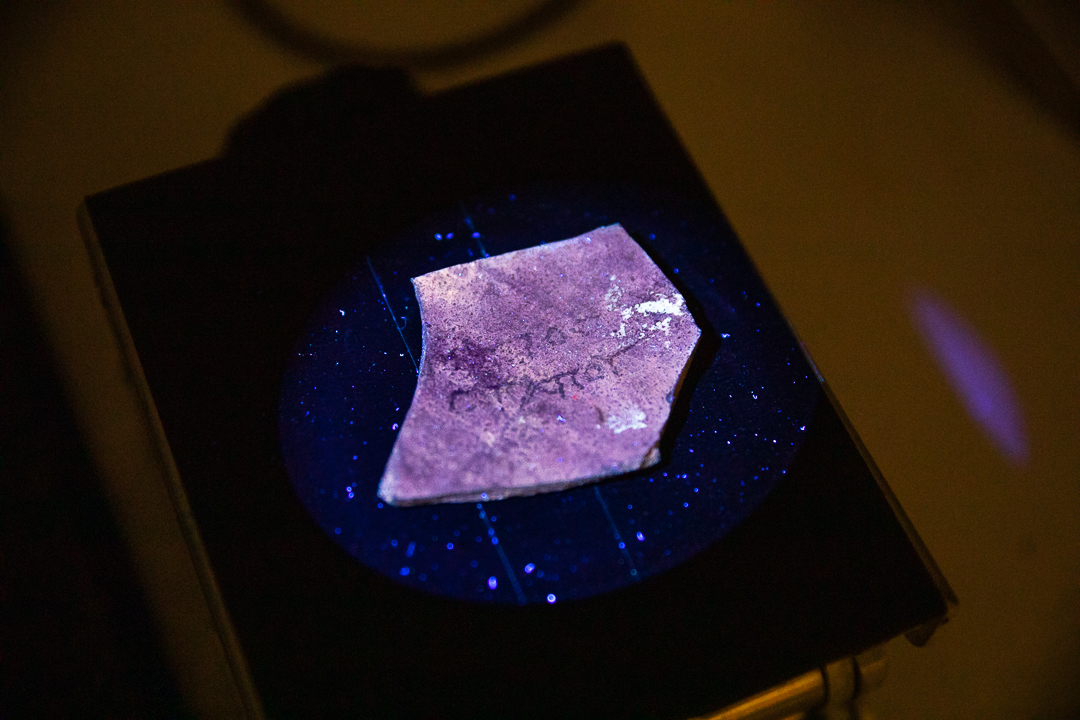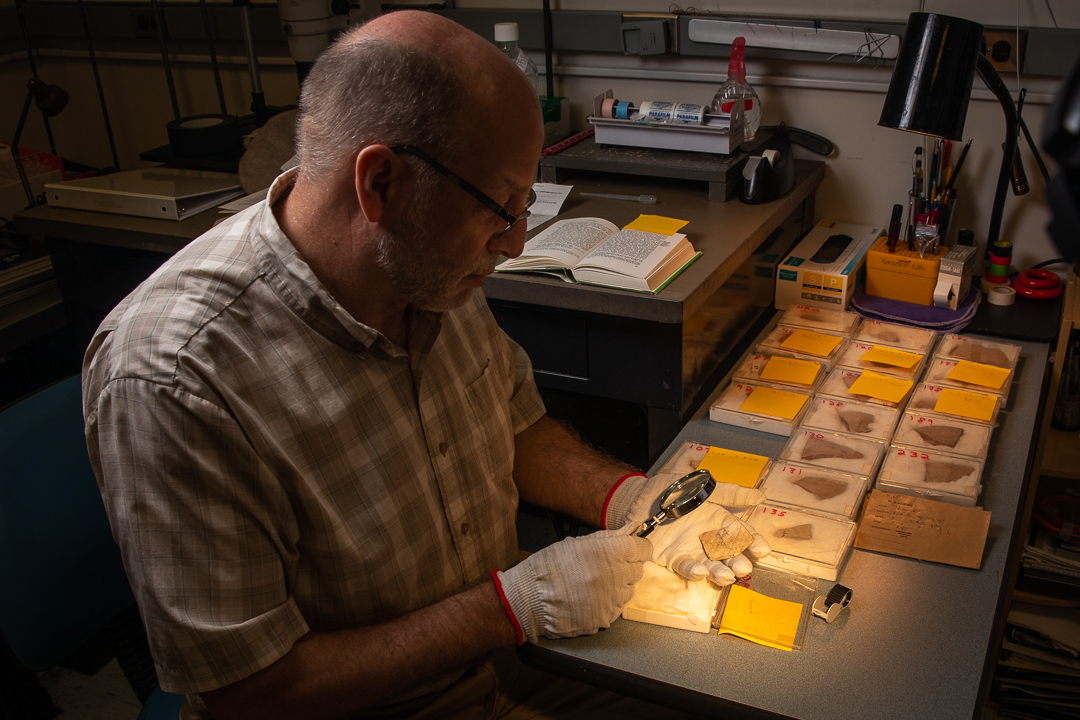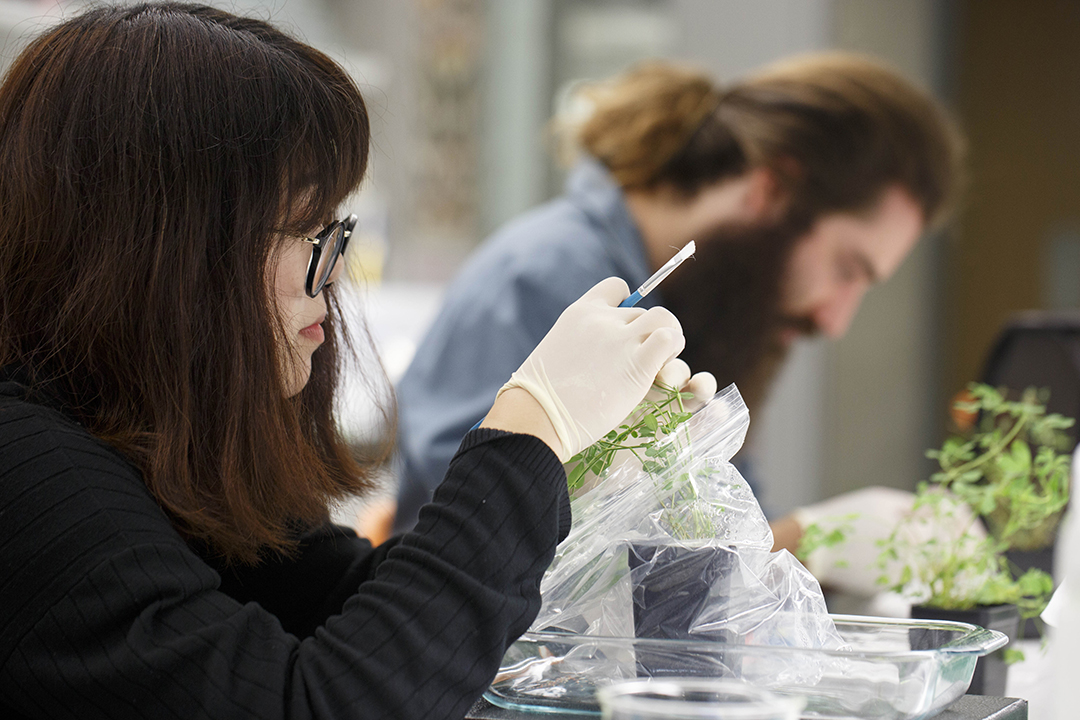By Kristen Mitchell
A Columbian College of Arts and Sciences professor is using cutting-edge imaging technology to decipher the inscriptions on fragments of broken pottery excavated more than 50 years ago in Jordan. The fragments, long thought to be lost, were recently rediscovered.
The fragments, called ostraca, were discovered at the site of Machaerus, a well-known archaeological site connected with notable historical and religious figures of the first century including Herod the Great and John the Baptist. Chris Rollston, associate professor of northwest Semitic languages and literature, took possession of 20 ostraca in May and used multispectral imaging equipment at the GW School of Medicine and Health Sciences to examine the pieces and their faded ink writing more closely.
Multispectral images capture data from multiple wavelengths on the electromagnetic spectrum and provide details the eye cannot see. Dr. Rollston believes at least 19 of the 20 pieces he is studying contain writing.
“The ink is carbon-based and was made, in part, using ancient ash. Some of the ink is really clear, but some of it is faded,” he said. “Multispectral imaging is capable of enhancing the ink so that one can read it more readily. During the past five to 10 years, multispectral imaging has really been front and center in the decipherment of ancient writings made with ink.”
[video:https://vimeo.com/362588131 width:560 height:315 align:center lightbox_title:CCAS Research]
Ancient Post-it Notes
Before these ostraca became a useful window to the past, they were pieces of household pottery used to hold water, food and other goods. When they broke, they were repurposed and transformed into “the post-it notes of antiquity,” Dr. Rollston said.
Ostraca were used to write down temporarily important, but not memorable, information, such as what kind of supplies needed restocked after a battle— an ancient grocery list. If the people of Levant knew scholars today were pouring over ostraca, they would be a little perplexed, Dr. Rollston said.
The important writings were typically made on papyrus and animal skin, which largely disintegrated over time due to the environmental conditions near the Mediterranian Sea and have been lost. There are a few exceptions, such as the well-preserved Dead Sea Scrolls, but ancient papyrus generally fared better in drier climates like Egypt.
The ostraca Dr. Rollston is studying now were excavated in 1968 by E. Jerry Vardaman, the founding director of Mississippi State’s Cobb Institute of Archaeology. The pieces, thought to be lost, were recently discovered by the late Dr. Vardaman's wife and researcher Marylinda Govaars. The Cobb Institute took possession of these items, contacted Dr. Rollston about interpreting the Aramaic and Greek inscriptions and gave him permission to conduct research and publish the ostraca.
Dr. Govaars, a researcher from Texas who has worked closely with Dr. Vardaman’s collection, is analyzing the archeological context of these nearly 2,000-year-old ostraca. Dr. Rollston and Dr. Govaars plan to publish a journal article on the pieces next year.
While the ostraca are brief, Dr. Rollston believes they could include information that could help researchers better understand cultural practices in the first century. He believes some of the ostraca written in Aramaic include the names and titles of Jewish soldiers who served during the First Jewish Revolt. This would shed light on naming practices of the time and provide insight on a significant time in Jewish history.
“It's difficult to know exactly when these inscriptions were written, but my sense is they were written sometime during the decade or two right prior to fall of Judaea to the Romans,” he said. “These are inscriptions from this really pivotal period in what we know as ancient Judaea.”
While ostraca themselves contain mostly trivial information, experts are able to gain insight into the past when they can connect the pieces with the context in which they were found. If ostraca are removed from their archeological site and where they came from is not recorded, the significance of their inscriptions is muted.
Dr. Rollston is currently working on a book about writing and scribal practices in Second Temple Judaism and early Christianity, and he plans to incorporate what he learns from these ostraca. When he completes his work, he will return the pieces to the Cobb Institute.

Multispectral images capture data from multiple wavelengths on the electromagnetic spectrum. These images can provide a sharper view of the faded ink writing on ostraca. (Harrison Jones/ GW Today)
Interdisciplinary Collaboration
Dr. Rollston said being able to bring these items to GW to study has had a huge impact on this project. He’s been able to foster new collaborations with faculty members like Narine Sarvazyan, SMHS professor of pharmacology and physiology, who has allowed him to use imaging equipment in her lab. He’s also connected with School of Engineering and Applied Science Professor Murray Loew, an expert in Reflectance Transformation Imaging (RTI), a computational photographic method that captures an object and enables researchers to re-light that item from any direction.
There is a particular helpfulness and camaraderie among colleagues to share expertise and develop new ideas, Dr. Rollston said.
“I don’t have to search far and wide for some place or some people in the U.S. who are capable of doing this sort of imaging,” he said. “They’re right here, and there’s something quite nice about that as well, to simply turn to the GW community and work together with them.”
This project has also opened doors to future collaborations within CCAS. Dr. Rollston planning to travel to Armenia later this year with Eric Cline, professor of classics, anthropology and history, to look at excavated items.



